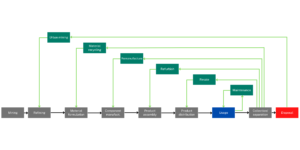2019, Tura, Hanski, Ahola, Ståhle, Piiparinen & Valkokari
Public policy taxonomy for a UK circular economy
CE-Hub, 2024
To build a shared understanding of the circular economy (CE) as a systemic innovation framework among stakeholders in the UK, the CE-Hub has identified the need for a taxonomy or classification of terms and entities as a key first step to concisely describe the current state of play, a desired CE target state and chart the transformation steps and inputs required to get there. As a core component of this and synthesising lessons from across the UKRI NICER Programme, the CE-Hub has developed an agnostic value-chain based framework to structure the actors, activities and steps involved in the transformation of resources from materials through to components and products, disposal or re-circulation and revalorisation pathways (Figure 1). This has been applied within the NICER Programme to date to help retrieve and map data across cases and support consistent visualization.

Figure 1. The CE-Hub value chain taxonomy schematic (Zils, 2023)
Anchored to the value chain taxonomy and focusing initially on levers available to public sector actors in the regulation landscape, this discussion paper outlines a high-level classification of public policy tools or instruments that can be applied by government actors to enable CE-related outcomes in the UK. ‘Regulation’ here refers to instruments or tools employed by an actor (or group of actors) to set controls and deliver change in a desired way/towards a desired state. CErelated outcomes include improved product design, extended and optimized product lifespans and greater revalorisation of materials, components and products at end of life, which have the potential to generate positive environmental, economic and social impacts in the UK. The taxonomy of public policy instruments outlined in the document is intended to help:
- Give a structure for building evidence on the scope, depth and stringency of the current UK regulatory landscape as it relates to the CE, to aid the comparison of options and identification of shifts and gaps; and
- Provide a framework for making consistent recommendations for policy pathways to effectively and efficiently move the UK towards a more circular, resource efficient and sustainable economy.
Accordingly, Section 1 of this CE-Hub working paper sets the scene of why we need a UK CE, guiding principles, key potential benefits and the rationale for a taxonomic approach. Section 2 then defines actors with a potentially significant role in aligning UK value chains with the principles of a CE and provides examples of the different roles (and responsibilities) each can have. This builds off a classification developed by the UNECE, while recognizing actors can be sub-divided in different ways. With actors mapped, Section 3 classifies instruments available to government actors to enable CE outcomes and provides examples of how these have been deployed to date. We include also a list of wider forms of soft influence that Governments and the public sector can have to enable, promote and facilitate CE outcomes.
Section 4 sets out key criteria for policy tool selection, considering the type of CE outcome sought to be targeted and how, as well as criteria that can be used to appraise options. These criteria include effectiveness; efficiency; financial cost to the public sector; long-run effects; distributional and equity considerations; positive and negative spillovers and strategic fit. Section 5 builds off the value chain taxonomy defined to illustrate a series of potential policy pathways for CE change at a systems scale in the UK through to 2040 based on CE-Hub policy work to date. We present illustrative examples of policies to initially impact materials and products, technological, social and economic changes, and some of the actors who would be (need to be) incentivised or disincentivised.
Examples of similar specific CE interventions from the five NICER Circular Economy Centres in relation to their resource flows will be published in the future. Policy instruments in this report will be discussed in more detail in a forthcoming short series, starting with the role of bans and standards in driving a UK CE. The overarching value chain taxonomy forms the core analytical framework for the NICER CE data observatory, which integrates data and CE intervention analysis across the NICER Programme, and will be launched in 2024. Other working papers published by the CE-Hub cover publicly accessible data sources relevant to measuring and modelling a UK CE (Lysaght et al. 2022), key performance indicators (KPIs) (Zils et al. 2023) and analytical methods to support and improve the consistency of CE measurement and appraisal (Khedmati-Morasae et al. forthcoming).
Please download the full report from the link below.






